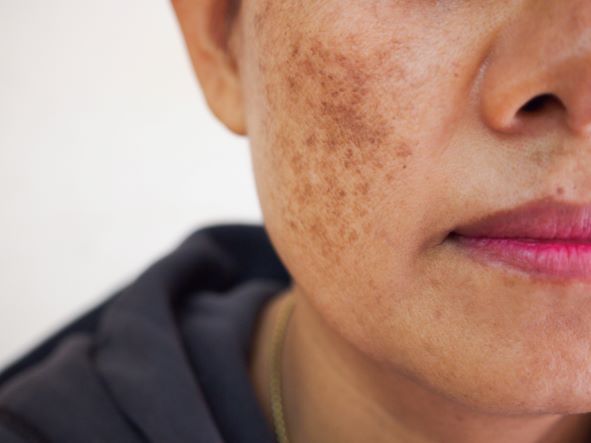Hyperpigmentation is one of the most common skin health concerns. It’s not really one skin condition, but a term used to describe the darkening of the skin that can occur for a variety of reasons. Hyperpigmentation can impact anyone of any age, and it can occur on any part of the body. According to Dr. Megan Lent of U.S. Dermatology Partners in Overland Park, Kansas, and Chillicothe, Missouri, “The vast majority of people will experience some form of hyperpigmentation during their lifetime. In most cases, it’s absolutely nothing to worry about. However, some changes in the color or texture of the skin can be indicative of more serious skin health concerns, so it’s important to confirm that any darker spots are hyperpigmentation.” In this blog, you can learn more about what hyperpigmentation looks like and what treatments are available for this condition.
What Is Hyperpigmentation?
Hyperpigmentation, simply put, is just an area of skin that is darker than surrounding skin. People of any skin tone and type may develop hyperpigmentation. The darker spots may be very small dots or cover larger areas of the skin, depending on the type and underlying cause of the hyperpigmentation.
Are There Different Types of Hyperpigmentation?
Dr. Lent says, “Hyperpigmentation refers to small or large patches of skin which are darker than the surrounding skin and may be associated with a variety of skin conditions. During your diagnosis visit, your dermatologist will help you identify the type of hyperpigmentation. This can help you plan for preventive steps as well as determine any treatments that may be necessary.”
There are three main types of hyperpigmentation:
- Solar lentigines – Also known as liver spots, age spots, or sun spots, these dark spots appear on areas of the skin that receive repeated or prolonged sun exposure (often the face and the backs of the hands). The effects of sun exposure are cumulative, and as we age, damage from the sun’s UVA and UVB rays can lead to darker patches on the skin.
- Melasma – This condition is most common in pregnant women, so it’s often referred to as the mask of pregnancy, but it can also be seen in non-pregnant adult females, and less commonly in males. Melasma causes large, darkly colored patches of skin that most often appear on the sun-exposed areas of the face, neck, and chest.
- Post-inflammatory hyperpigmentation – This type of hyperpigmentation occurs after an injury, surgery, or flare-up in a chronic skin condition (including acne, eczema, and psoriasis). Following an injury or inflammation, the skin may appear darker in the affected area.
In addition to these main causes, patients may also experience hyperpigmentation as a reaction to certain medications, as a side effect of medical conditions, or for a variety of other reasons.
What Causes Hyperpigmentation?
While different types of hyperpigmentation may develop for a range of reasons, the root cause of hyperpigmentation is the production of excessive amounts of melanin compared with other areas of skin. Hyperpigmentation is more likely to develop on areas of the skin that receive frequent exposure to the sun. As you may have noticed if you ever had a sunburn or a tan, sun exposure can cause an overproduction of melanin that darkens the skin, so it’s no surprise these areas are more likely to be impacted by hyperpigmentation
How Is Hyperpigmentation Treated?
When it comes to recommended treatments for hyperpigmentation, Dr. Lent says, “Because hyperpigmentation isn’t dangerous, treatment isn’t necessary, but if patients are unhappy with the appearance of dark spots, they can choose to seek treatment to improve the appearance of hyperpigmentation. In most cases, the available treatment options are conservative, and many effective treatments are available over-the-counter.”
Commonly recommended treatments for hyperpigmentation include:
- Prescription topical medications – These topical medications are used to lighten dark spots, and they often contain hydroquinone. These topical medications can be effective, but they are not appropriate for long-term use. Over time, hydroquinone can actually lead to a darkening of the skin known as ochronosis.
- Over-the-counter topical treatments – In addition to prescription medications, many non-prescription topical treatments can help to reduce the appearance of dark spots, including products that contain azelaic acid, kojic acid, vitamin C, or retinoids. These products can minimally improve the appearance of hyperpigmentation, and when used as part of your daily skincare routine, they can help prevent the development of new dark spots.
- Corticosteroids – For hyperpigmentation caused by inflammation, corticosteroids can help to lighten the appearance of dark spots on the skin. A topical corticosteroid may be recommended for use in combination with other lightening agents because they promote healing and can help to prevent skin-darkening during the healing process.
- Chemical peels – A chemical peel can be used to remove the outer layers of skin, revealing healthy, new skin below. The new layers of skin often have a more even skin tone.
- Microdermabrasion – This treatment uses an abrasive product to remove the outer layers of skin. Like chemical peels, this reveals the healthier and more even skin below.
- Microneedling – Like chemical peels and microdermabrasion, microneedling improves the appearance of dark spots by removing the outer layers of skin. Additionally, microneedling creates small injuries that prompt the skin to begin the healing process and jumpstart the production of collagen, leading to healthier, more beautiful skin.
- Laser therapy – Laser light is applied to the dark area of the skin. The intense pulses of light break down the pigment, allowing the body to process these pigments out naturally.
- IPL photorejuvenation – intense pulsed light (IPL) photorejuvenation is a treatment often recommended to reduce the appearance of redness and hyperpigmentation.
Can I Prevent Hyperpigmentation?
According to Dr. Lent, “The main way to prevent hyperpigmentation is to limit sun exposure and use sunscreen every day. Following a surgery, injury, or flare-up in acne or other skin conditions, don’t pick at the skin. This can increase your risk for post-inflammatory hyperpigmentation.”
Ready to Work with a Dermatologist to Treat Hyperpigmentation?
If you want to improve the appearance of hyperpigmentation or you want confirmation that dark spots are not anything more serious, it’s time to schedule a visit to a U.S. Dermatology Partners location in your area. It’s easy to start working with one of our knowledgeable dermatologists. You simply need to take a few minutes to complete our online scheduling request form. Once we receive your request, a member of our local team will be in touch to answer any questions you have and finalize the details of your visit.
Find a location near me
or


